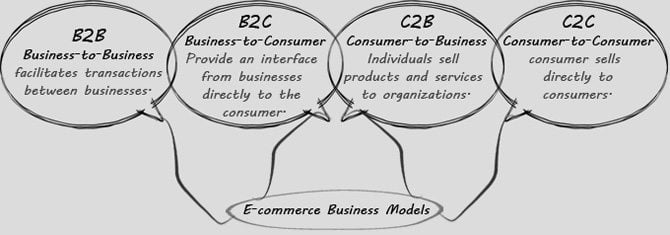Different Types of eCommerce – How Many of them Do You Know?
This article may appear to be "educational"; however, we hope our readers will forgive us for this small lesson. Many of us, including merchants and customers, are involved in online business somehow nowadays, so, it would be better to fill in the gaps in our knowledge, if there are any.
Have you ever asked yourself a question how many different types of eCommerce are in the marketplace? What are the types of eCommerce existing nowadays? Maybe your customers wanted to order neither a PrestaShop nor an OpenCart website, but something like B2C or C2C and their request puzzled you? Then, take your time and read this post. It will help you avoid confusing the definitions and sound more convincing and professional next time the request arises.
Did you know that types of eCommerce platforms can be classified according to their licensing model, sales scenario and data exchange? Would you like to plunge into details? Read on, the most interesting facts are below.
Licensing models breakdown
On-premise eCommerce
This kind of eCommerce software requires an initial one time purchase investment (licensing fees), as a rule. The customer will also have to invest some money in hardware and installation services. But that’s not all. Data migration and on-going maintenance, as well as yearly fees for software updates and support, should be taken into account. Here are some examples of typical on-premise eCommerce platforms: Hybris, Intershop Communications, Sana Commerce., Oorjit. and IBM WebSphere. On-premise eCommerce platforms are easy to customize, and are secure and reliable in terms of performance. But they demand considerable initial investment, self-maintenance and technical knowledge.
Software as a service (SaaS) eCommerce
SaaS is a cloud based delivery model, where each application is hosted and managed in a service provider's datacenter. It is paid for on a subscription basis. Shopify and Demandware are two prominent examples of typical SaaS eCommerce solutions. Unlike on-premise eCommerce, SaaS is affordable, hosted and upgraded by an eCommerce provider and easily scalable. As a result, its integration with back-end systems is limited; it lacks data security and doesn’t provide full control over the system.
Open source eCommerce
Every developer knows that open source eCommerce is a free platform allowing users to install, maintain, secure and configure the software on their own servers. To set up an open source platform, you need basic technical expertise in web design and development fields. The source code of software products labeled as open source can be accessed and modified by users. PayCart, PrestaShop, osCommerce, Magento and Thelia are some examples of typical open source eCommerce platforms. The main advantages of open source eCommerce are that it's free of charge; there is a wide variety of different addons (plugins, extensions) available to boost its functionality; plus it provides better flexibility with a customizable source code. A kind of fly in the ointment, or downside, is that more technical knowledge is required; and the website’s performance depends on hosting costs and it has no standard integration with back-end system.
Sales scenario breakdown
B2C or Business-to-Consumer
It’s quite evident that in a Business-to-Consumer e-Commerce environment, companies sell their goods online to the end user, the end users of their products or services. Any visitor can access B2C eCommerce web stores. There is no need to login if you want to make any product related inquiry.
B2B or Business-to-Business
In a B2B eCommerce environment, companies sell their goods online to other companies. They are not engaged in sales to the consumer public, it’s a trade sale, or services like CRM. In this case entering that type of web shop requires a log in. B2B web stores usually contain customer-specific pricing, assortments and discounts.
C2B or Consumer-to-Business
In C2B eCommerce environment, consumers offer their products or services online and companies post their bids. Then consumers review the bids and choose companies that meet their price expectations.
C2C Consumer-to-Consumer
One of the most well-known examples of C2C eCommerce environment is eBay. Here consumers sell their goods to other consumers.
Types of data exchange breakdown
It’s a well-known fact that eCommerce software retrieves information from a dedicated back-end system. Here are a couple of examples for you: an Enterprise resource planning (ERP) or Customer relationship management (CRM) system. This information is stored in the relevant system’s database. The Business logic includes all of the business rules defining the way data is stored, created, displayed, calculated and recreated inside an ERP or CRM system. For instance: different product discounts are applied for different customer accounts. Two types of data exchange are taken into account to retrieve the information.
Integrated eCommerce
In integrated eCommerce, a part of the software solution is installed into the back-end system. This way connection between the business logic and database of a back-end system is configured automatically. Information available in the back-end system is re-used and displayed in the front/back end of the eCommerce system. An integrated eCommerce software product doesn't require any investments in the re-creation of a separate database or business logic. It re-uses those of the back-end system instead. Integrated eCommerce software is often used in B2B and B2C scenarios. Sana Commerce is a typical example of integrated eCommerce software.
Interfaced eCommerce
In interfaced eCommerce, the software solution is installed on top of the back-end system. So, the connection between the business logic and database of a back-end system is set up manually. Information available in the back-end system is duplicated into the eCommerce software. Interfaced eCommerce software products have their own database and business logic that is synchronized constantly through a connection to a certain back-end system. Interfaced eCommerce is mostly used in a B2C scenario. Magento is a good example of interfacing eCommerce software.
* * *
Do you still follow me? That’s all for now. Please let us know if this blog post was useful to you. How many types of eCommerce do you know now? Did it enrich or maybe reorganize your knowledge of the matter? Please, share your comments with the community and make the author happy.
Get more to your email
Subscribe to our newsletter and access exclusive content and offers available only to MonsterPost subscribers.




Leave a Reply
You must be logged in to post a comment.